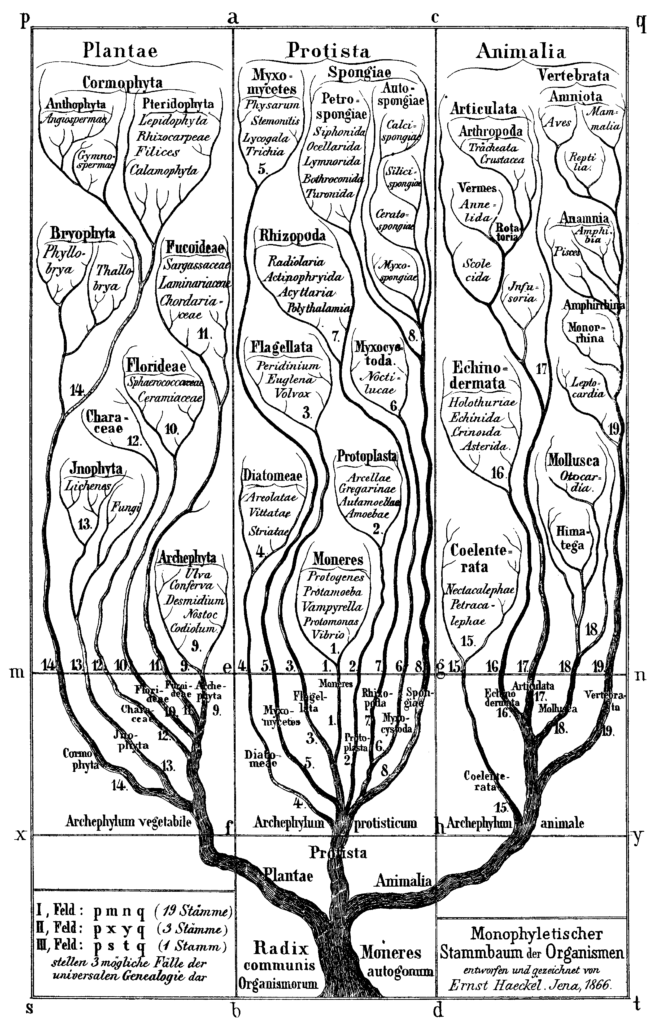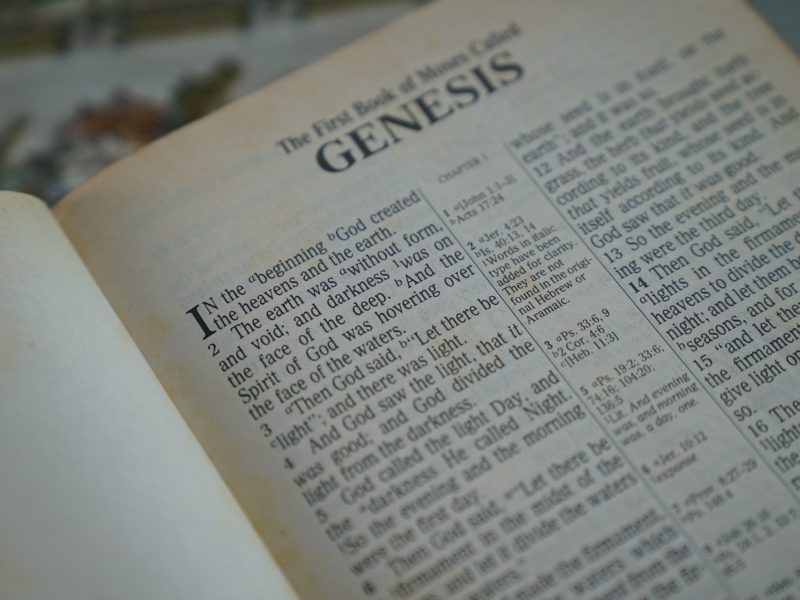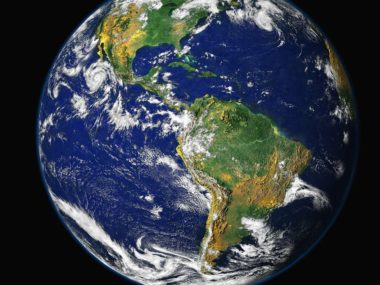We’re taught in public schools that evolution is a scientific fact. Evolution is the theory that all life descended from a universal common ancestor over billions of years of slow process. Many also claim that evolutionary principles are the basis of all science. To teach creationism, some suggest, is to send society toward failure.
On the flip side, many of us learn in church that creation is the biblical foundation of origins. It is the basis for all of existence and the beginning of God’s redemptive plan.
Maybe you’re reading this blog and you’re committed to your diehard stance. But maybe you’re here looking for answers. Maybe you sometimes wonder why you believe what you believe―a vital question to ask yourself. Here at the New Creation blog, we stand on biblical, young-earth creationism. We believe that there is plentiful evidence found in the universe supporting this biblical worldview.
So, why not evolution?
First and foremost, our foundation for creationism is the holy Word of God. From the very first words of Scripture written by Moses, we learn that “In the beginning, God created the heavens and the earth” (Genesis 1:1). The passage describes the words spoken by God as He breathed the universe into existence. It also lays out the order in which God created and the quality to which He completed His creation. He declared everything “good,” after he breathed it into existence.1
The Problem of Deep Time
Contrary to the biblical narrative, some suppose that God simply “used evolution” to create the world. This idea, called theistic evolution, has several problems. Firstly, Scripture contains no indication of the deep time required for naturalistic evolution.
Moses uses the Hebrew word yom, which means “day,” to explain the timeline of the creation. But was it really a literal day? Yom can also describe a period of time. For example, Genesis 4:3, “In the course of time [yom] Cain brought to the LORD an offering of the fruit of the ground…” (emphasis added).
Yet the context of Genesis 1-2 shows no indication that “day” is a poetic analogy. Moses uses the same word yom to command the keeping of the Sabbath day in the Ten Commandments.
“For in six days the Lord made heaven and earth, the sea, and all that is in them, and rested on the seventh day. Therefore the Lord blessed the Sabbath day and made it holy.”
Exodus 20:11 ESV
Additionally, each and every day of Creation was paired with a “morning and evening,” indicating one, regular day-night cycle. Not only is this implied, but God explicitly “called the light ‘day’” in Genesis 1:3-5!
When read plainly, it is clear to the reader that Moses—the human author of both the creation account and the Ten Commandments—considered Creation Week to be a literal, seven day week.
The Problem of the Timeline
For the sake of argument, let’s imagine that the “days” in which God created were not 24-hour days, but millions of years of God using evolution. Will the text allow for this interpretation?
When considering the proposed order in which all things would have evolved—beginning with the Big Bang and the formation of the cosmos, followed by life “finding a way”—we see that the lineup conflicts with the order clearly listed in the text of Scripture.2 For example, if God caused plants to evolve on “Day 3”, how would they have survived for millions of years without performing sun-dependent photosynthesis? It wasn’t until “Day 4” that the sun came into existence.
The order in which God created the animals is another problem for theistic evolution. The proposed order in which organisms evolved versus the order in which Scripture records their creation contradict each other. For example, the evolutionary timeline asserts that birds evolved from theropod dinosaurs. According to the text, God created birds on Day 5 among the flying creatures. Land-animals, including theropods, would have been created on Day 6!
The Death Dilemma
The point to drive it home, however, is the order in which death and sin came into the “very good” world that God created. God created all things without sin, but when sin entered the world, death followed (Genesis 2:17, 3, Romans 5:12, 8:20-21). God had warned Adam and Eve of the consequences of rebellion: “…For in the day that you eat of it you shall surely die.” (Genesis 2:17 ESV.)
“…Just as sin came into the world through one man, and death through sin, and so death spread to all men because all sinned…”
Romans 5:12 ESV
Scripture is very clear about the manner in which death was inaugurated. Theistic evolution, however, requires millions of years of death and suffering to eventually lead to the evolution of man. This is an unbiblical and theologically troubling position. If death was a natural part of existence before sin, then God’s claim that rebellion would lead to death was an empty threat, and Jesus died needlessly.3 For a much more in depth discussion on theistic evolution and its implications, see Stephen Lloyd’s pamphlet.4
So theistic evolution, then, does not hold up.
The Psalms
Genesis is not the only biblical account of God creating all things. Let’s look at the writings in three Psalms:
“The earth is the Lord’s and the fullness thereof, the world and those who dwell therein, for he has founded it upon the seas and established it upon the rivers.”
Psalm 24:1-2, ESV
In these verses, David proclaims God’s ownership over his creation.
“He set the earth on its foundations, so that it should never be moved.”
Psalm 104:5, ESV
Here we see the writer of Psalm 104 proclaim God’s sovereignty over creation. He has made all things and holds them together (also see Colossians 1:17).
“Know that the LORD, he is God! It is He who made us, and we are his…”
Psalm 100:3
Why does God own all of the world and those who live in it? He made the world, and He also made us. We are not our own, and we did not come about by accident.
The New Testament View
Jesus
Jesus himself held to a literal interpretation of the creation account. When questioned by the Pharisees about divorce, Jesus cites Creation and the beginning of marriage in Genesis 1-2. Mark 10 records this conversation:
“Jesus said to them…‘But from the beginning of creation, “God made them male and female…”’”
Mark 10:6, ESV
Jesus quotes Genesis as a historical, literal, and authoritative account. He cited this Scripture to answer questions about how God instituted marriage and followed it with instructions on how one should live. He saw it as a literal story demanding a literal response.
The Apostles
The Apostle John echoes the Genesis account of the beginning in his gospel. Genesis records God creating through His words, and John explains that Jesus is the Word of God. John 1:1-3 says, “In the beginning was the Word, and the Word was with God, and the Word was God. He was in the beginning with God. All things were made through him, and without him was not any thing made that was made.”
In the early church, amongst persecution, the apostles began a prayer by addressing God as “Sovereign Lord, who made the heaven and the earth and the sea and everything in them…”
Acts 4:24, ESV
Paul the Apostle, author of thirteen New Testament books, writes in Colossians 1:15-16, “[Jesus] is the image of the invisible God, the firstborn of all creation. For by him all things were created, in heaven and on earth, visible and invisible, whether thrones or dominions or rulers or authorities—all things were created through him and for him.”
The writer of Hebrews also testifies that God created all things by His words:
“By faith we understand that the universe was created by the word of God, so that what is seen was not made out of things that are visible.”
Hebrews 11:3, ESV
So we see that all over Scripture, God is the Creator, speaking into existence all things. There is no indication in the text that God used naturalistic, evolutionary processes to bring the world into its current state.
What Does Science Say?
Now that we have our foundation for biblical creation, we can look at the world around us and take note of physical evidence for what God has done and Who He is. It truly glorifies God to study His creation, observe His glory (Psalm 19), and see His invisible attributes through what He has made (Romans 1:20). One of my favorite accounts in Scripture is when Jesus pointed to the lilies of the field and the birds of the air. He presented His listeners with ecological examples of God’s faithfulness, proving to them why they did not need to worry about their lives. He provides for His creation, and we see this in His world.
Along with His faithfulness, we also see evidence in creation of His judgment. Whatever your stance on where the Flood boundaries are, geologically speaking, we can look at deposits of sediment and fossils as a reminder that though this world was originally “good” and sinless, the curse on sin has caused all creation to groan and suffer the consequences of sin (Romans 8:20). When I spend time in the field digging for dinosaur fossils, it reminds me of the death and destruction that occurred during the Flood because of God’s just dealing with sin. He is also faithful in His promise to never again destroy the earth in that manner.
Let’s look at some pieces of evidence of God’s handiwork and sovereignty over the earth: created kinds, genetic complexity, geological processes and preserved original material.
Created Kinds
Evolutionary theory suggests that all living things descended from common ancestry. In this worldview, we would expect to find much similarity, and perhaps transitional forms, linking all organisms to this ancestor. Distantly related organisms would possess much more dissimilarity. Novel changes, often over long periods of time, eventually separated the major groups of organisms from each other. These are the branches of the Tree of Life. Dogs are much more recognizably different from birds than cats, for example, because they are on different evolutionary branches. Biblical creationism takes a different approach to explaining dissimilarity between living things. Creationists can take a deeper look into both similarities and dissimilarities from a biblical perspective using baraminology.

Baraminology
Baraminology investigates which animal groups may belong to the same original, created kinds. God created all living things during Creation Week, and Scripture states that He created plants and animals to multiply “after their kinds” (Genesis 1:24). Noah brought the animals onto the Ark according to “their kinds,” as well (Genesis 6:19). This implies that there are recognizable differences between kinds.
With every animal and plant belonging to some “kind,” we can study the similarities and dissimilarities in both extinct and extant (living) animals. Using character datasets describing the morphology of the organisms, scientists can statistically compare species of interest. The results will determine if a species is discontinuous or continuous with another species. When there is significant dissimilarity, called discontinuity, the interpretation is that they are not within the same created kind. They are completely unrelated in this case. On the other hand, significant continuity between species suggests they are within the same kind.
The young-earth, Creation model predicts that there should be recognizable differences between the organisms which fill the world and the fossil record, and this is what scientific studies have been finding.5 Patterns of discontinuity between groups of organisms support the idea that God made all things specially and without gradual, naturalistic evolution.
Genetic Complexity
Another evidence of this is the incredible genetic complexity and design at a molecular level. As Dr. Leonard Brand and Dr. Art Chadwick note in Faith, Reason, and Earth History, it is extremely unlikely that the existence and complexity of DNA is the result of random mutations. For its random formation, 1) the mutations would have to occur in a timely manner when needed by the organisms for survival, 2) the mutations must not be reversed or harmful to the organism, and 3) the changes would have to be a preserved change.6
For any kind of adaptation to proceed, it must be passed on and fixed into the population. This is hard to imagine if DNA must be built by random processes. Additionally, genetic changes are dependent upon proteins working together perfectly within the cell. Those proteins must be coded for by DNA.7 This creates a major issue for the formation and functionality of DNA. Its formation requires proteins, but the proteins must be coded for by the DNA itself! Seeing God’s hand in creation through genetics is a never ending topic as we study the purposes and intricacies of life through experimental science.
Geological Processes
Further evidence for biblical, young-earth creationism concerns processes throughout the natural world. Let’s consider the rate of sedimentation deposits. Radiometric dating on rocks produces ages for deposits far older than the literal, 6-day Creation model would suggest. Some researchers present these ages to support the idea that processes like sedimentation rates are the same today as they have always been. We can look at other data regarding the geologic column to make interpretations about timing of events. Sedimentation rates show that geological processes may have occurred at a much faster rate in the past.8,9 This is important when looking at the geologic column as a whole, as well as interpreting the age of the earth and the timing of when rocks and fossils were formed. Dr. Leonard Brand points out in his writings that there is much less sediment in the geologic column than one would expect if the conventional model of deep time is accurate.10,11
Another assumption we might have based on the idea that the geologic record formed over the span of deep time is that any distinct layers of bedding (or strata) would eventually be homogenized by bioturbation. Bioturbations are the natural, biological processes from plant roots and animal burrowing. After all, if a layer of sediment is lying around for tens of millions of years, you would expect evidence of animal and plant life to be evident. Although there is some evidence of such activity, most of the sediment found throughout the fossil-bearing layers of the geologic record lacks the volume and homogenization predicted, indicating recent—and potentially catastrophic—deposition of the sediment.12

Original Organics in Fossils
The last evidence we will mention here is the presence of organic and soft tissue in fossils that are supposedly tens of thousands to millions of years old. The disintegration of original tissues, whether proteins such as collagen or DNA, should take place rapidly (within a few tens of thousands of years). This is due to oxidizing processes, hydrolysis, and decomposition. Yet fossils conventionally dated to 400 million years old have soft tissue components preserved.13 Additionally, Carbon-14 shouldn’t be in fossils older than 90,000 years old, either, yet there is evidence of C-14 in Cretaceous fossils. Researchers have yet to sufficiently test any explanation for such occurrences, but the presence of soft tissue certainly fits in with a young-earth/Flood model.
So, why not evolution?
Biological and geological evidence support a young earth and a recent Flood event. But ultimately, friends, we believe by faith. All of the science in the world could point to either naturalistic evolution or creationism, but that is sinking sand. The data may say one thing today and tomorrow another. The Word of God is unchanging. Let us hold fast to biblical truth.
“By faith we understand that the universe was created by the word of God, so that what is seen was not made out of things that are visible.”
Hebrews 11:3, ESV
Footnotes
- The one exception we see is in Genesis 2:18, when man was alone, an incomplete and not yet “very good” condition. For an in-depth discussion on what “very good” means in the context of the Creation account, please refer to Klein, Z. and Hannah Klein. 2020. “Effects of the Fall on the Physical Creation: A Biblical Analysis.” Answers Research Journal. ↩︎
- McLain, Matthew. (2021). Adam and the Apes: Does it Matter? Lecture given at Cornerstone Fellowship Bible Church. ↩︎
- Lloyd, Stephen. (2017). Adam or Death: Which Came First? https://www.biblicalcreationtrust.org/resources-booklets.html ↩︎
- Lloyd, 2017 (Footnote 3) ↩︎
- Wood, Todd. (2011). Sediba, Senter, and a new journal. http://toddcwood.blogspot.com/2011/07/sediba-senter-and-new-journal.html ↩︎
- Brand, L. and A. Chadwick (2016). Faith, Reason, and Earth History, Andrews University Press. ↩︎
- Brand, L. (2007). “Wholistic Geology: Geology Before, During, and After the Biblical Flood.” Origins(61): 7-34. https://www.grisda.org/assets/public/publications/origins/61007.pdf ↩︎
- Brand and Chadwick, 2016. (Footnote 6) ↩︎
- Brand, L., 2007, 7-34. (Footnote 7) ↩︎
- Brand and Chadwick, 2016. (Footnote 6) ↩︎
- Brand, L., 2007, 7-34. (Footnote 7) ↩︎
- Brand, 2007, 7-34. (Footnote 7) ↩︎
- Thomas, Brian (2013) “A Review of Original Tissue Fossils and Their Age Implications,” Proceedings of the International Conference on Creationism: Vol. 7 , Article 14. Available at: https://digitalcommons.cedarville.edu/icc_proceedings/vol7/iss1/14 ↩︎












i didnt read all but i want to add this argument: suppose that we will see a reproducing robot ( lets say even with DNA) on a far planet. do we need to conclude design or a natural process in this case? remember that according to evolution if its made from organic components and have a self replicating system we need to conclude a natural process because it has living traits. but we know that even a reproducing robot is evidence for design. therefore a penguin for instance (which is a kind of a walking organic robot basically) need design too
Hi Gav,
Thanks for the comment. We definitely observe design all over the universe. As you’ve pointed out, even natural processes in creation point to God’s hand. He causes the world to run by certain physical laws. Whether you observe an entire ecosystem or one cell, it is evident that there is order, law, and process, all designed by God for His glory.
Noel
thanks (and sorry for my english by the way). actually, according to atheism the whole universe was made by a natural process. thus, even a plastic robot is the end-product of a natural process (big bang). but we know that its not logical. by the way, my name is guy (my bad).